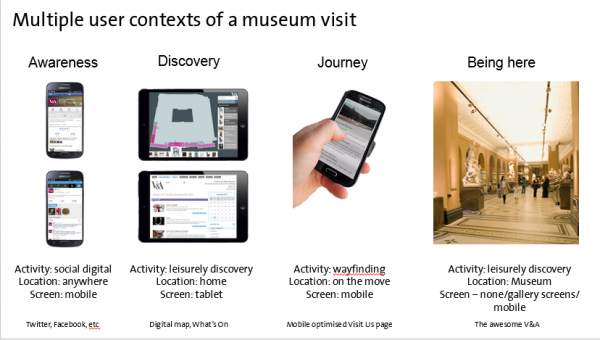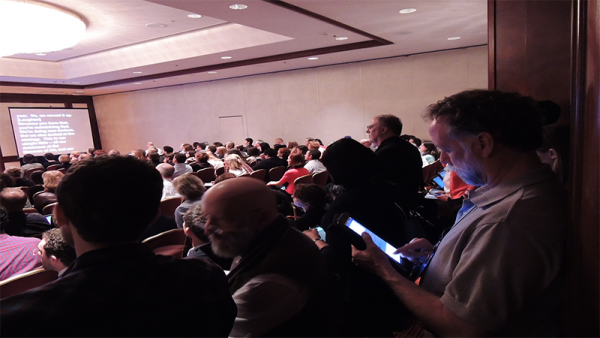Museums and the Web Baltimore was as thought-provoking and inspiring as ever. With the day-job specifics turned off, it is truly invigorating to open up the mind in the company of 600 or so museum professionals working at the coalface of digital in museums. Here are some key takeaways for me.
Это теперь доступен на русском языке – This post is available in a Russian translation:
No single theme or trend?
At previous Museums and the Web there has always been one or two connecting themes that emerge naturally from the various sessions I go to. These have usually been obvious – things like “mobile” or “digitisation” or “open data” and so on.
This year it seemed very different. I struggled to find any particular standout theme.
There was a marked diversity of sessions showing a mature and established pattern of working with the reality of digital information and widespread adoption of digital devices. What this really shows is that digital has arrived and is embedded in all aspects of museum work – but it is not predictable.
So in fact the closest I could say was a theme was that…
Digital is everywhere and mutating unpredictably
It has arrived and is now everywhere, affecting everything. The diversity of papers reflected this. They also showed that the impact of everyday digital is not predictable and shows no sign of becoming so any time soon. It was reassuring too, that the discussion in papers and sessions has noticeably moved away from an idea that digital is going to affect museums. It already has changed people’s lives and continues to do, so let’s get over that one.
I kind of like this!

Here are some thoughts and pics…
Data management is maturing
By definition digital services are built upon data and the discussions of data management have long since moved on from simple debates about which is the best stats package and comparisons of visit/page counts.
The standout example of the maturing development of data management was Rob Stein and Bruce Wyman’s discussion of their solution for managing visitor engagement data at the Dallas Museum of Art (DMA Friends). The approach emphasized the repeat participation of visitors with the museum’s collections and programs, offered customized rewards in return for frequent engagement to give the museum the ability to track individual activity. With nearly fifty thousand unique visitors joining in the first year and great data to match, this impressive project scooped two Best of the Web Awards.
Stein made the point that this sort of holistic data view is actually quite common and mature in other sectors such as retail. Modest as ever, he was open in saying that this is not new. Just maybe uncommon in the museum sector.
Paper available here:
Slides available here:
Digital services all produce data. If this is not considered, they will exude data regardless of whether we understand its potential. Getting value from data needs a managed approach. This should not just be based on what data comes out by chance. Planning how data will need to be used is an essential part of digital service management. At the very least, it is required simply to monitor objectives.
So it was a nice touch in this project was that the data output, and how it might be used, was planned during development. For example, they had adjusted the data collection process early on to ensure they would get formats that would work with specific visualisation tools. This is great stuff. A key challenge of data management is deciding how best it can be conveyed to effect change. Visualiation is a key tool for this.
And so…
Presenting visual information effectively is as important as the data itself
Visualisation makes data easier to use and therefore makes management of digital services more effective.
Another example exploring visualisation was Craig MacDonald’s lightning talk about an attempt to create a standard assessment of the effectiveness of user experiences. The paper looked at engagement with three focuses: visceral, behavioural and reflective. The information was interesting, but it was the spiderweb graph visualisation (below) that offered a promise of a ready comparison. This is something people can use to make sense of comparative data in a way that a massive dump of data cannot.
Slides available here:
Alex Espinós of La Magnética showed further impressive visualisations of deep intearaction on Twitter, which was a refreshing change to the rather meaningless follow stats that used to be held up as success when Twitter first emerged. This chart highlights leading museums based upon their real levels of social interactions with their audiences.
Paper available here:
My own workshop on data tracking was a pragmatic introduction to setting up navigational behaviour tracking and linking to Google Analytics to give complex segmentation and to take advantage of the existing graphs it can give and further visualisations available due to Analytics wide support (e.g. in Tableau and other visualisation tools).
This was based on the work we have implemented on the V&A website which is outlined in this post:
Visualisations don’t need to be data heavy either. I use this slide to convey broad concepts of how people swicth devices and behaviours within even seemingly simple situations such as the journey from awareness to museum visit.
There is Google Analytics data behind this, but the data itself does not get the point across anything like as well as four simple images with captions.
Mobile is understood as a default requirement, but still not yet widely delivered
There was a refreshing lack of debate about whether providing mobile-friendly services matters – Of course it does, duh!
Lessons are being learned from having implemented mobile services, not from debating if it is required.
There was a great review of findings from a study of mobile interpretation at the National Gallery London from Frankly, Green and Webb which stressed the central importance of good content in any mobile service, and of testing what users though of the content. They can be enjoyably frank!
Paper available here:
Slides available here:
Mobile what exactly?
I believe it is a basic requirement of any website that its display and function should optimise on a mobile.This is by no means universally implemented by all museums.It seems that for quite a lot of organisations, the mobile offer is still a device-specific app.
This is acceptable to provide a special service that offers extended functionality in specific circumstances that normal HTML can’t yet deliver.
BUT – apps are not an alternative to having basic responsive mobile-optimised pages. It may simply be that it is easier and sexier to make cool one-off apps. I suspect the resource cost of making many such apps would be more than the cost of making an entire site responsive.
To me, this is an area where museums appear to be lagging behind audiences’ needs. Consumer trend data is clear – smart mobile access is a daily fact of life for the majority of our audiences. Not having a site that is responsive to offer optimised views for mobile phones is not meeting a common expectation.
In audiences’ eyes, I wonder if not having a responsive website might seem as old-fashioned for a museum’s image as a stern gatekeeper expression implying that they adjust to the rules of the Museum and not the other way round?
I was surprised how few people had a basic mobile display for their website in my session on planning for responsive web services. The paper and accompanying presentation are here:
The unpredictable churn of digital is a major management challenge
The biggest challenge I believe from seeing the range of work at MW2014 is the unpredictability of change and the risk of investing in technologies that arise then disappear. Museum budgets are finite.
One of the great strengths of this and other conferences is the opportunity to learn from people who are doing it and leap frog the community’s knowledge for the next team starting work. Hats off to all the MW people who are doing it for real and sharing it. As Nancy Proctor said in her opening speech: “It is much harder to drive the cart than kick the cart.”
While mobile-delivered services and related management options have become relatively well understood in scope and scale, compared to even a few years ago, it is sobering to see that many organisations have yet to fund the changes that most audiences expect.
Tablets are now starting to produce mature evidence from implementations that utilise their different characteristics. Tablets have produced an audience expectation that touch control is provided on screens. This might seem small, but it is a major change. If you put a screen into a gallery, people expect it will be touch-enabled.
Amongst the papers on touch in galleries was this one by Marthe de Vet and Jolein van Kregten of the Van Gogh Museum:
Another example of tablets affecting user expectation was this paper by Lawrence Chiles and Lucinda Blaser. They discuss their use of tablets to combine data with tablets for the interactive Big Map experience in the National Maritime Museum in London:
Scary stuff
But digital change is of course far from being just about mobile and tablet devices. It is exciting but daunting to consider these really are the “easy ones”.
There are many digital developments that are not yet predictable or stable, or even identified!
On the visible horizon is hands free voice-activated control with Siri, Microsoft Cortana and Google Now available for mobile phones. Google Glass takes this a step further. Glass was demonstrated in a forum on wearable technology by Neal Stimler Liz Neely and Robert Stein and a lightning talk by Juan Sanabria. Sanabria highlighted a key advantage of Glass being able to provide live streamed first-person video. Who knows what this may yet mean for museums?

Similarly the next killer audience benefit that voice systems may deliver may not even come from phones, but could come leftfield from in-car developments.
If you find it slightly alarming that mobile sites are now simply expected, and we should be looking at the next consumer trends in preparation for a new wave of change, then get this…
The really fun stuff from Disney
Disney’s Eric Brockmeyer opened the conference with a barnstorming overview of digital prototypes. Eric has the enviable job of thinking new technological ways of giving audiences magical experiences – how awesome is that?!
Eric showcased so many inspiring projects, which included…
Using a finger to relay a spoken message to some else’s ear…
Printed lights and chess pieces with data connectivity built in…
Firing micro-vortices of air to stimulate hairs as environmental feedback…
Digitally-controlled lenses in toys
Changeable degrees of friction as physical feedback on a surface…
I took loads of other conference pictures, available here. (rocking the hat Nancy, BTW)
Summary
What can I say. I came away having learned loads, helped others learn and generally got a headful of ideas about the implications and possibilities of digital – love it.
The conference website is here and many session listed here have links to full papers or presentations:
http://mw2014.museumsandtheweb.com/program/

















